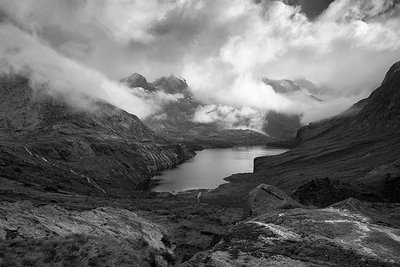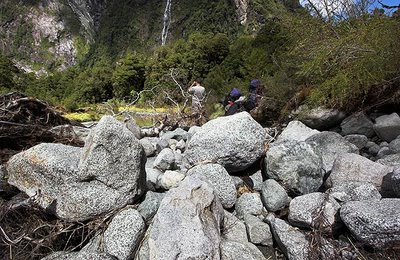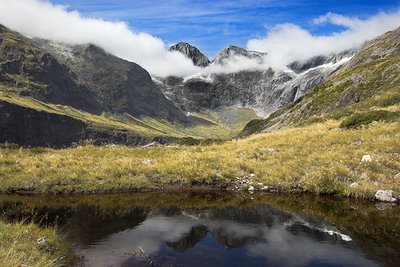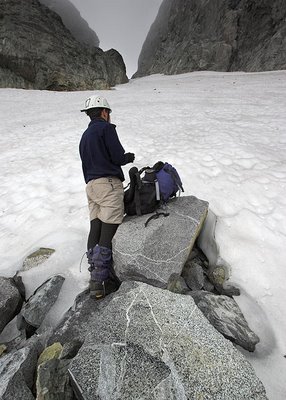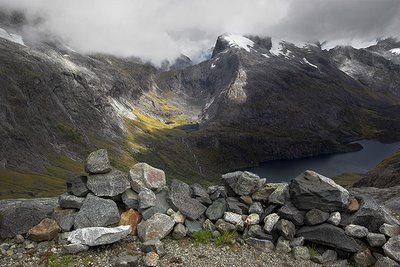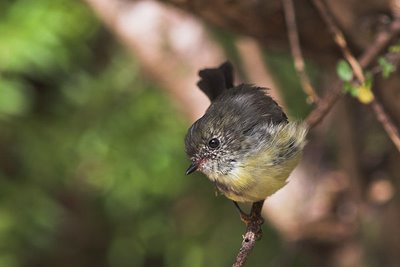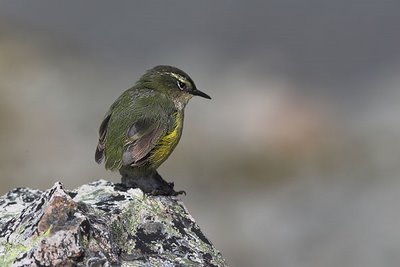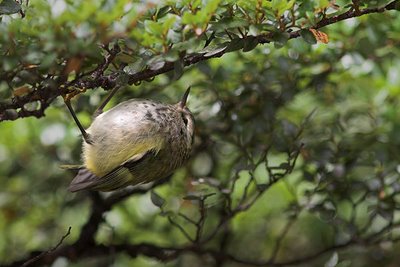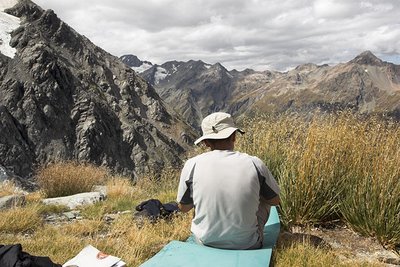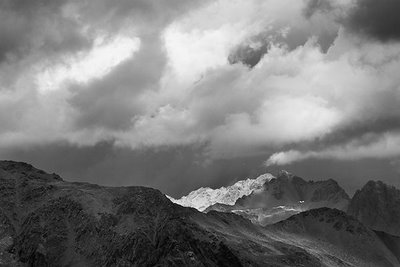
Early afternoon on Friday 3 February. The summit of Mt Rolleston
[1] is enveloped in mist; it’s calm, mild, and the rock’s warm. From far below, the faint sound of water falling over rock drifts up through a quiet world.
It’s taken us about five hours from the car: up the Otira Valley to the foot of the Slide, where we’d strapped crampons to boots, then climbed the steep, rock and boulder strewn snow, occasionally scrambling awkwardly over rock to bypass ‘schrunds
[2] where the shrinking snowfield’s pulled away from the mountainside. Earlier in the season this would be just a long plod but now the underlying rock has begun to emerge, in places separating the snow slope. Higher up the Slide, we removed our crampons and climbed as much as possible on solid rock, from time to time struggling up loose scree—“swimming,” Jonathan calls it—until finally we reached Goldney Ridge. There, perched on a giant, flat-topped, level rock the size of a small room, we ate lunch and admired the views: loose rock, solid rock, a glimpse of old snow, and beyond a hundred metres or so in every direction, nothing but mist. For a few minutes, the cloud below us thinned, treating us to a view of the head of the Bealey Valley and its small, nondescript glacier. Then it closed in again.
We climbed to the Low Peak, still cocooned in cloud. I felt worn out and weary but wasn’t about to call it quits. Crevasses on the Crow névé
[3] —the easy route—cut off the Middle and High Peaks, but we negotiated the summit ridge with no real problems: just one or two slightly exposed sections a few moves long, with the awareness of a long fall below—a little nervewracking but not scary enough to encourage thoughts of roping up. And, despite my tiredness, I enjoyed the scrambling; enjoyed the feel of climbing, using hands and feet and balance, sometimes crossing one foot behind and over the other in a movement resembling yoga or a dance—joy in the feeling of controlled, deliberate, graceful movement, accentuated by its purpose. This wasn’t a mere trudge with effort as the primary, or only, requirement; this required skill, finesse, coordination.
It’s good to be here, even if we can see little from the summit. The climb hasn’t been technical, but there’s still that sense of achievement, and, most importantly, we know we’ll be able to descend the straightforward way if we return to climb the Otira Face of the mountain. All we need is reasonable weather.
We reverse the moves along the ridge to the Low Peak and descend the upper section of Goldney Ridge, down loose scree and short outcrops of sound rock. In places, it’s as if the bones of the mountain have emerged, the disintegrating cover of blocky rubble falling from an underlying, hard skeleton. The cloud’s closing in, releasing its rain—just enough to wet the rock. We check the route carefully in the restricted visibility, aware of the bluffs all around and not wishing to face a climb back up to retrace our steps. After some tentative exploration, we find an old abseil anchor; Jonathan sees a cairn across the gully, and we traverse across, finding an easy way down to the top of the Slide. It’s crampons again, and the long, knee-straining descent to the head of the Valley. Nine and half hours after leaving the car, we’re back there, just ahead of a torrential downpour. Great timing—and a great day.
...
We returned to the Otira Valley the next day to look for the sunglasses I’d left sitting on a rock near the terminus of the glacier. Several parties had already made their way partway up the track, and as we ap

proached the head of the valley we met an elderly man accompanied by a gentle, quietly spoken, younger man. They were returning from somewhere higher, somewhere on the ridge—I don’t know which ridge they referred to, but they must have started early. I asked if they’d noticed any sunglasses.
“Yes,” the younger man said, and immediately began retrieving them from his pack, assuming without question that they must be mine. They were, and I felt slightly sorry to disappoint him—he must have thought it was his lucky day. The older man seemed reluctant to join the conversation, but when I addressed him directly, he began explaining how much he loved being in this environment; how, in the past, he’d climbed Rolleston innumerable times, with many people—here he mentioned legendary New Zealand climbers like Lynn Crawford—and how it didn’t matter to him whether he reached the summit or not.
“The journey is the destination,” I suggested.
He nodded, deliberately, recognising the truth of it. “The journey is the destination,” he said.
...
Morning: not a cloud in the sky; brilliantly fine weather with a chill to it; perfect for the Central Direct route on the Otira Face of Rolleston.
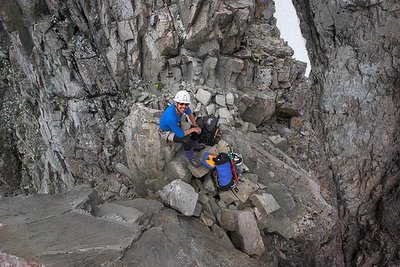
We’re up at 6:30, away at 7:45 and walking up the track by 8 a.m., right on schedule, with sun lighting up the head of the Otira valley. But, by the time we stop at the footbridge to shed jackets, our beautiful day has begun to deteriorate; cloud encroaches over Temple Basin and Phipps and streamers of mist flow up from the Bealey, over the Pass and down towards the Otira gorge. We carry on. As the Face comes into view we see the buttress remains free of cloud for most of its height but the uppermost section and the summit have been obliterated by a shifting veil of grey, drizzly cloud. The southerly front the forecasters had said would pass through overnight hasn’t: this is it arriving.
We decide to press on and at least reconnoitre the approach to the climb, assuming we’ll be back tomorrow after the front’s gone. By the time we’re climbing the tedious, blocky scree to the bluffs, drizzle has begun to wet the rock and any prospect of a successful climb fades as the world darkens. We ascend a short, near-vertical gut, partly solid rock, partly soil and moss and tiny, tough plants, and walk up rough slabs to peer into the gulch that provides the usual access to the buttress. In the dull, heavy light and oppressive mist it’s an evil-looking place. The top remains hidden, curving out of sight behind vertical rock and disappearing into cloud. It looks to be an awkward scramble to reach a ramp of old snow we hope will take us out onto the snowfield below the buttress.
Light rain has darkened rock and scree; it gleams, slick in the dull light. I shiver; having stopped to discuss what to do, I’m cooling rapidly. I’m inclined to call it a day, as going higher will achieve little but require a substantial effort the weather’s unlikely to improve. Jonathan agrees, so we downclimb the mossy gut in the wet and begin the tedious scree-hopping back down the valley.
...
The novelty of pasta or couscous had begun to wear off. We needed something fresher for dinner, but the only vegetables at the store at Arthur’s Pass were in cans
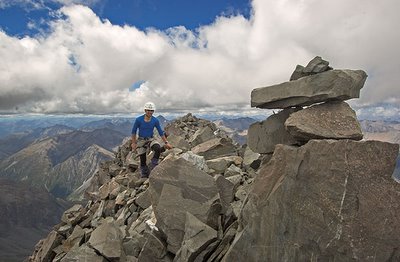
—there wasn’t an onion in sight. Perhaps Otira might have something, and it’ll be a nice drive; spectacular and not too far. At the Otira hotel we walked past the verandah where a collection of locals leaned over the rail or lounged about, drinks in hand, watching us curiously as we headed for the tearooms, a small annexe to the pub. I nodded to them, said hi, feeling as if I’d been teleported deep into the Appalachians and half expecting to hear a banjo start up. Inside the shop, the owner, not just of the tearooms and pub, but the entire town, appeared behind the counter. We’d already discovered there were no vegetables.
“We’re on the hunt for vegetables,” I said. “In particular, an onion or two.”
“Hmm..., vegetables, eh?” He stood there looking slightly puzzled, as if trying to recall what a vegetable was and whether it might be a brand of beer. I asked him where the closest place might be where we could buy some vegetables. He thought for a long time.
“Well,” he said at last, “I’d say the closest would be either Greymouth or Hokitika!”
We thanked him and started to leave, having no intention of driving hours for an onion. He came out from behind the counter and followed us, clearly intrigued by the idea of vegetables.
“I could fix you up with a can of peas?” he offered, but it wasn’t really what we were looking for.
We walked back to the car, past the lined-up locals on the verandah. They seem to have relaxed a little, and even smiled at us; in a rush of goodwill, I almost joined them for a beer. Almost.
Dinner that evening wasn’t memorable—I can’t remember it.
...
Waitangi Day, 6 February 2006. Two hours after leaving the car we’re back at the foot of the Face, looking at the access gully. After yesterday’s rain, the snow ramp has collapsed, making the gut an even more dubious

prospect. However, the alternative—the bluff to the left; near vertical, hung with mossy vegetation and running with water—looks even less appealing, so we explore the gully. Where the snow begins, so do the difficulties. Jonathan investigates the gap where the ramp has melted away from the sheer rock wall, while I strap crampons on and climb uneasily up the steep, hard snow, aware of how the middle section had collapsed within the last 24 hours and wondering how close it might be to collapsing further under my weight. I try to weigh less.
Neither route proves acceptably safe, so I check the rock on the other side of the ramp but quickly back off and we agree: the bluff is the only feasible option—one that leaves me with a sinking feeling. Probably fear.
By the time I’ve packed away my crampons, Jono’s out of sight, picking a way up through the bluffs. I follow, all too aware I can’t afford a single slip; that a moment off balance could prove irrecoverable. The only positive thing is the moss—in fact, it’s a tough, matted mixture of small, gnarly, subalpine plants clinging tenaciously to the rock; where thick enough, it provides a

brilliantly solid placement for the pick of my iceaxe. Otherwise it’s horrible—a scary scamble which we later agree is probably the crux of the entire climb. I whimper my way up, not sure whether to be grateful to Jono for leading the way or to curse him for not giving up.
The rewards are relief when I can finally walk upright without needing my hands, and the spectacular sense of height and airiness. Already the Otira Valley seems enormously far below and the world’s a wild jumble of peaks receding to the blue-hazed horizon. The buttress looms above us, ascending into deep blue sky; the summit’s out of sight. Here, where we can move about freely, we put harnesses on and I arrange the rack—a few slings, a selection of nuts and carabiners. Jono leaves the rope at the top of his pack, quickly accessible. I wonder where we’ll need it; apparently most parties rope up for at least one pitch, but nothing we can see above looks too serious and it’s far faster to climb unroped.
In fact, much of the lower part of the climb is the solid, “warm, red sandstone” we’ve expected. It’s a joy to clamber over, but higher up, patches of looser rock require each hold to be tested. None of the climbing is particularly technical and the rope stays in Jonathan’s pack, despite occasional sections where, looking down, I realise a slip would send me bouncing to the bottom of the face. But, for the most part, the holds are good and the route keeps opening up.
At one o’clock we reach a tiny saddle in a narrow section of the ridge. It’s an hour and a half from the foot of the buttress and a perfect place for lunch; somewhere we can sit and place our packs; move around carefully and take a few photos. I peer over into the gully on the western side and feel the slight off-balance sense of incipient vertigo.
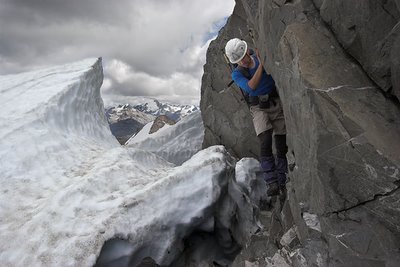
It’s a long way down, and you wouldn’t hit much on the way. Backing off, I look up at the ridge above us. It’s narrow and steep and appears a far more serious proposition; perhaps somewhere up there we’ll find the pitch where we’ll rope up.
In fact, it’s not as bad as it looks. The climbing seems easier and mostly less exposed, but perhaps I’m distracted by my delight in the amazing views—the Otira Valley so far below; the head of the Waimakariri with the col leading to the Rolleston River; everywhere, mountains tinged with the purple-blue haze of great distance. Grey and white clouds laze in the sky, scattered about above the land, drifting their shadows over valleys, mountainsides, ridges, snowfields. The final section of the climb is on good rock, steep but without the nerve-tingling exposure of some lower sections. At 2 p.m. we reach the summit.
There’s no wind, just a sporadic breeze. We stay for an hour, nibbling snacks, taking photos, watching the light. I feel as if I could stay here for the rest of the day—I

don’t want to miss anything; want to savour as much of this as possible. I give one of the rocks an appreciative pat and thank Rolleston for allowing us the climb. I mean it. By the time we get back to the car we’ll have traversed the upper Otira Valley eight times in the last five days: as Jonathan jokes, “we’ll be grizzled veterans of the Otira Valley”. Well, perhaps a little overstatement there... but we’ve certainly come to know it well; it feels familiar; when I return in the unforseeable future it’ll have an element of homecoming.
But, I wonder... perhaps coming to know a place—mountains, coast, sea, hills, all of those and more—is only part of a story; the story of a relationship, an interaction. Perhaps the other part of that story is allowing time for the place to begin to understand you.
Notes:1
. Mt Rolleston is the dominant peak near the township of Arthur's Pass.
2. "Schrund" is a contraction of "bergschrund", the crevasse-like gap where a glacier or snowfield has pulled away from the rock.
3. A névé is the uppermost section of a glacier.
Photo 1: Jonathan inspects the approach gully on our first reconnoitre of the Otira Face.
Photo 2: Snow saddle on the summit ridge of Rolleston.
Photo 3: Our lunch spot partway up the Otira Face.
Photo 4: The summit, looking East.
Photo 5: Crevasses on the Crow névé.
Photo 6: Crow névé schrund, below the summit.
Photo 7: Jono negotiates the schrund on our way to the Low Peak.
Photo 8: This, as promised, is the rifleman, titipounamu, Acanthisitta chloris. A pair of these tiny birds entertained us at the NZ Alpine Club Lodge in Arthur's Pass township.
Photos and words © 2006 Pete McGregor






